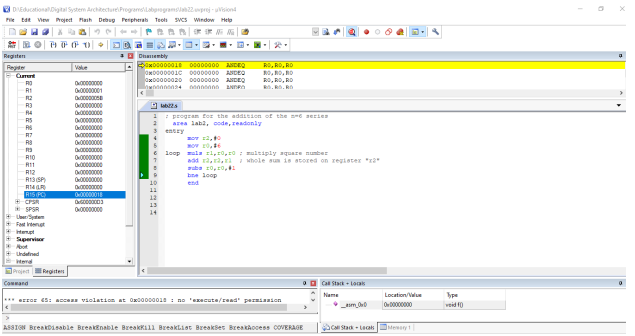Hello Dear Readers,
Today in this post I will provide some basics to advanced ARM's assembly language practice QA part-2, I have used the Keil tool for code writing.
Q-1). Write an assembly language program for storing the sum of first ‘n=6’ terms of the series 1,4,9,16,25…..
Code:
; program for the addition of the n=6 series
area sum_series, code,readonly
entry
mov r2,#0
mov r0,#6
loop
muls r1,r0,r0 ; multiply square number
add r2,r2,r1 ; whole sum is stored on register "r2"
subs r0,r0,#1
bne loop
end
Output:
Q-2). Write an assembly language program to find the maximum of 3 numbers and store it at location 0x5000.
Code:
; program to find maximum number of 3 and store in memory
area max, code, readonly
entry
ldr r0,=data
ldr r3,=0x5000
ldr r4,=0x03 ;create a loop of 3
ldr r1,[r0, #4]
sub r4,r4,#1
again
ldr r2,[r0]
cmp r1,r2
bcs loop ; jump on set carry
mov r1,r2
loop
add r0,r0,#4
sub r4,r4,#1
bne again
str r1,[r3]
stop b stop
data dcd 0x07,0x08,0x09
end
Output:
Q-3). Write an assembly language program for counting the total occurrences of a given ‘n=3’-bit pattern '110' in a 32-bit value.
Code:
; program to count occurance of the sequences in the given 32 bit value
area count, code, readonly
entry
ldr r0, =data
mov r3, #0 ; value of the occurance stored
mov r4, #32 ;defined for one bit calculation
mov r5, #6
ldr r1, [r0]
next
mov r1, r1, ror #1
mov r2, r1
ands r6, r2, r5 ; anding operation for identify sequences
subs r6, r6, r5
beq again
subs r4, r4, #0x1
bne next
b stop
again
add r3, r3, #0x1
subs r4, r4, #0x1
bne next
stop b stop
data dcd 0x98654353
end
Output:
Q-4). Write an assembly language program to count the total factors of a number.
Code:
; program to find totals number of factors
area factor, code, readonly
entry
ldr r0,=data
ldr r1,[r0] ; take example of 4 so number of factor is 3(i.e 1,2,4)
mov r4,r1
mov r2,#1 ; initial value for division
mov r3,#0
next
cmp r4,r2
bcs loop1
stop b stop
loop
add r3,r3,#1
again
add r2,r2,#1
mov r1,r4
b next
loop1
subtract
SUBS r1,r1,r2
beq loop
bhi subtract
b again
data dcd 0x04
end
Output:
Q-5). Write an assembly language program to find maximum and minimum values in an array.
Code:
; program to find maximum and minimum value from an array
area max_min, code, readonly
entry
ldr r0,=data
ldr r1,=0x05
ldr r3,[r0] ; maximum value stored on r3 register
ldr r4,[r0] ; minimum value stored on r4 register next
ldr r2,[r0] ; it is reference register
cmp r3,r2
bcs loop
mov r3,r2
loop
cmp r4,r2
bls again
mov r4,r2
again
add r0,r0,#4
subs r1,r1,#1
bne next
stop b stop
data dcd 0x03,0x04,0x5,0x7,0x9
end
Output:
Q-6). Write an assembly language program to find the average of first ‘n’ natural numbers.
Code:
; program for calculating average of 'N' natural numbers
area avg,code,readonly
entry
ldr r0,=7
mov r2,r0
next
add r1,r1,r0 ; addition of all the numbers 7+6+5.....
subs r0,r0,#1
bne next ; repeat untill addition comes to 0 from the given value
again
sub r1,r1,r2 ; For repeated subtraction
add r3,#1 ; r1 is stored remainder
cmp r1,r2 ; value in r3 is quotient
bge again
end
Output:







Wow bro I can't have words for you. Please keep it up to advanced algorithms.
ReplyDelete